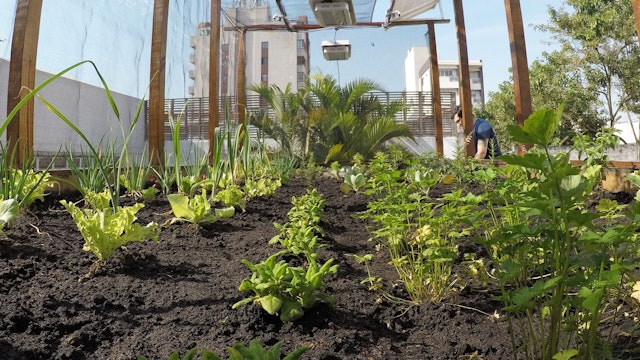Can Media.Monks continue ‘extreme growth’ while keeping green?
Media.Monks’ Q3 results show the digital marketing company is making good on its promise of ‘extreme growth,‘ but can it balance shareholder expectations with its sustainability plans?

Media.Monks’ chief of sustainability tells The Drum how it hopes to stay green as it posts significant growth figures for Q3
Sustainable growth is something of a holy grail for marketing agencies. Bringing zero-emission targets together with business ambitions is a particularly choice goal for Media.Monks. The challenger network, founded by Sir Martin Sorrell as an acquisitive, high-growth vehicle, wants to eat its rivals‘ lunch – but it also wants to lead the race to cut the ad industry‘s environmental impact. It’s going to be very difficult to do both.
Media.Monks and S4‘s results, released today, show significant growth: Q3 revenue was up 106%, year-to-date revenue is up 101%, and its two-year comparison with pre-pandemic figures shows a revenue increase of 65%. Billings have now reached £865m for the year-to-date.
According to Sorrell: “The pandemic has proven to be an accelerator of digital marketing transformation and we are taking full advantage of this opportunity by choosing to invest a proportion of our EBITDA margin in growth.“
It‘s a good time for Jason Day, executive vice-president of growth for EMEA, to begin working for the company; he has just joined from WPP. Day is determined to help achieve annual growth targets for Media.Monks, with a broad focus on expanding the breadth and depth of its client roster, particularly in western Europe and the Middle East.
“We are undergoing extreme growth. As our company gets larger there are going to be more complex things for us to work on, there’s going to be more multi-market opportunities. I‘m coming in to help drive that growth, make sure we’re onboarding those larger, more complex accounts and delivering high-quality work.“
According to Day, the conditions for that “extreme growth“ already exist across much of his brief: “Consumers are increasingly sophisticated and there are a plethora of options for consumers to touch brands. That’s pretty much universal now, even when you look at markets that some may think are not as sophisticated.
“We‘ve definitely passed the moment between analog versus digital. We’re now digital as a species.“
The engine behind this growth is Media.Monks‘ digital and data practice. Day says: “It doesn‘t matter if you‘re in the Middle East, if you‘re in western Europe, if you‘re in Kenya or South Africa, consumers are on their phones and they’re on a screen. They’re having interactions with brands. And if it happens on a screen, we do it.“
But according to Regina Romeijn, the company‘s vice-president of business strategy and sustainability, measuring the ecological impact of Media.Monks‘ work on those screens – digital content, software, media buying – is still a tricky business. The industry is still coming to grips calculating carbon emissions of digital buys.
“Digital production is still a very vague, complex domain. If you look at the lifecycle, for example, of a website – from the moment a brief comes in, to the people involved and their time, the offices, everything that‘s involved until the end of life for that website – it‘s hard to know which buttons to push to reduce emissions. It‘s a black box.“
Difficulties in carbon auditing aside, Media.Monks has committed to reaching net zero on its emissions by 2024. It's also signed up to the Amazon Sustainability Climate Pledge, the European Green Deal, and has committed to contributing to UN sustainability goals by integrating them into its ESG strategy. Media.Monks has also been investing in reforestation programs across Europe, where its carbon emissions per head are highest. During a visit to Glasgow, in time for the international Cop26 climate summit, Romeijn tells The Drum that it hopes to make its carbon footprint over the last year (lower than normal, given employees were at home and travel was at a minimum) the benchmark going forward, rather than treating it as an anomaly.
“We want to have sustainable results; we prefer actually planting trees to just pushing emissions around on a piece of paper.“
Efforts to make the business more environmentally friendly aren‘t just about offsetting investments, she says – small initiatives can also make a difference. Its Singapore office penalizes workers who bring takeaway coffee cups into work; in São Paulo, wastewater is redirected into a herb garden on the premises.

Green mergers
Media.Monks‘ client work is partially also in service of these objectives. Day notes a major portion of its business means helping “heritage brands“ such as BMW, Allianz and Mondelez centralize their marketing operations and digitize every portion of their businesses; by making those enterprises more efficient, it’s helping them reduce their environmental impact.
Such talisman clients have been a particular target of founding chairman Sorrell, who celebrated the firm’s number of ‘whopper‘ accounts in this quarter‘s results; he wants to have 20 clients, each with $20m of revenue a year.
Its client work is also a key part of plans to ‘lead’ the industry in green credentials; its net-zero target is, after all, more ambitious than any put forward by rival holding companies.
Romeijn says it‘s a question of responsibility. “We are honestly looking into how we create our products. We can reduce emissions not just with technology and innovation, but by different choices that clients might not even be aware of.
“They‘ll send us a brief and we‘ll execute on it, but we also take responsibility ourselves to [ask] ... did you think about end-of-life cycles? Did you consider non-automatic downloads? Did you think about all the things that possibly have an impact on outputs? We are ourselves accountable for those outputs.“
But its sustainability work also has to take into account Media.Monks‘ appetite for acquisitions. Already this year it‘s acquired 10 companies, including Decoded Advertising, Staud Studio and Racooon Group, and has more cash in the attic for further purchases. Does incorporating new agencies into the network risk slowing Media.Monks‘ march to net zero?
Romeijn says the company’s plan can also onboard new agencies.
“Firstly, we analyze the maturity level of their own sustainability efforts – some of them are really quite advanced. Zemoga, for example, already has a fantastic ESG structure in place with total support from their board.
“On reporting, we usually wait until they have been with us for a full calendar year ... before we pull the numbers in, so we have time to clean up the data and make sure they are really integrated into our systems and our corporate way of working.“
As a result, a lack of green credentials wouldn’t put Media.Monks off acquiring an agency. “If their core capability is one we want to have, then we won’t be put off.“ But new partners can “piggyback“ on the network’s existing sustainability framework. “This is all in cooperation with all our brands. Everybody‘s involved, you can’t do this from an ivory tower.“
If an acquisition is trailing the rest of Media.Monks, it institutes environmental guidelines or renegotiates real estate contracts.
“If their offices are not green, we‘ll look and see if we can terminate the lease contracts ... [if they‘re not already], we‘ll get them to use renewable energy. Whatever is not in place, we put it in place.“
Talent requires sustainability
Media.Monks will also likely grow its headcount in the coming year. Day says he joined because he wanted to get his “teeth into something new and exciting“ and join the effort to “deliver fantastic work in a faster, more efficient, more effective way.“ Many others will doubtless be motivated similarly; there are now 6,926 monks on the books.
But Media.Monks is a young business. Romeijn argues that there are very few new recruits that arrive for work not already invested in the company’s sustainability work.
“It‘s impossible to work in a digital industry where you have lots of young people not to have some form of work on sustainability,“ she says.
“Talent requires it.“

